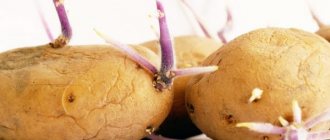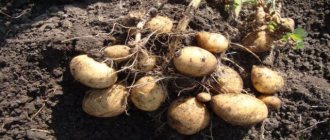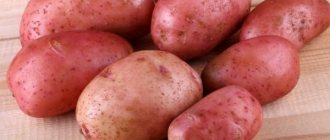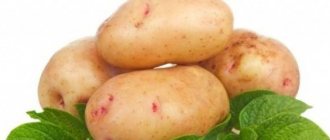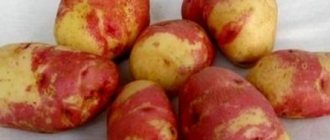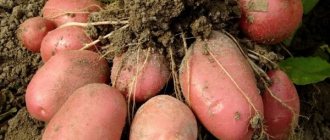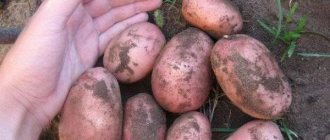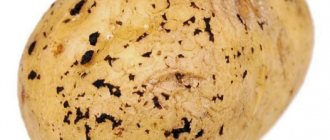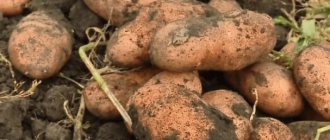High-yielding and unpretentious table potatoes Innovator has been present on the Russian market for more than ten years. Due to the plant's resistance to weather conditions, it has spread to many regions.
Origin story
The Innovator variety is the product of the work of Dutch breeders. In Russia, a new potato variety intended for commercial production has been grown since 2005, when it entered the State Register. Recommended for all central and Volga regions, i.e. climatic conditions of the central zone of the country. But it gained popularity in Siberia and the southern steppe regions. Now many farms are included in the State Register as domestic originators of seed material of the Innovator variety: from the Moscow region, Tyumen, Sverdlovsk regions, Stavropol Territory, Tatarstan.
Description of the variety
potatoes are distinguished by high yields, ease of care, and good taste . Medium-sized farms use it as the main representative of the crop for cultivation - due to its good shelf life.
Origin and development
The innovator was bred by Dutch breeders . On the territory of the Russian Federation it was included in the State Register in 2002. The new variety was intended for commercial production, but is also grown in household plots.
Chemical composition, trace elements and vitamins
Potatoes in 100 g (% of the daily value) contain from 12 to 15% starch . It contains:
- ascorbic acid – 24%;
- boron – 164%;
- vanadium – 373%;
- vitamin K – 13.3%;
- iron – 15.5%;
- potassium – 23%;
- cobalt – 50%;
- silicon – 167%;
- lithium – 77%;
- manganese – 16%;
- copper – 14%;
- molybdenum – 11%;
- pyridoxine – 15%;
- rubidium – 500%;
- folic and nicotinic acid – 10.5% each;
- oxalic acid – 7.8%.
Important! The composition of tubers includes replaceable and essential amino acids, saturated and unsaturated fatty acids, and purine bases. The volume of purines in 100 g is 5% of the daily value, which should be taken into account by patients with gout.
Ripening period
Potatoes belong to the mid-early group . Full ripening of the variety takes place in 75-85 days. The first digging during preliminary germination before planting is carried out on the 70th day.
Productivity
With proper planting in compliance with the requirements, you can get : on farms from 320 to 330 c/ha, on personal plots - from 15 to 30 kg/m2. The maximum volumes of potatoes were collected in the Kirov region - 344 c/ha. Each bush contains from 6 to 10 tubers.
Disease resistance
The variety has genetic immunity to potato canker and pale potato nematode. Average resistance is noted in relation to scab and late blight. Potatoes need protection from rhizoctonia.
Interesting things on the site:
High-yielding, frost-resistant potatoes “Zhuravinka”
Early ripening variety "Empress" for sowing seeds
Table potato variety “Krepysh” for temperate climates
Characteristics of tubers, description of appearance
Innovator has an oblong and oval tuber shape with a weight of 83-147 g . Light yellow peel with slight roughness, flat and small eyes. The pulp is light cream in color with a dense structure. Potatoes retain their color after cooking and are slightly boiled.
Which regions are best suited and climate requirements?
The Innovator variety is recommended for planting in the Central, Volga-Vyatka, and Central Black Earth regions.
Potatoes easily withstand short-term droughts, are suitable for planting in the southern steppe regions, and have become widespread in Siberia.
Description and characteristics
Stable yields have made the mid-early Innovator potato popular among industrial crop producers. Harvesting begins after 75-85 days of plant development. They get 320-330 centners per hectare. The maximum yield of the Innovator variety was obtained in the Kirov region: 344 c/ha. On personal plots with 1 m2 you can harvest 15 to 30 kg of potatoes. The marketability of the harvest ranges from 82 to 96%, there are few small tubers.
The Innovator potato bush develops up to 60-70 cm in height. Semi-erect, spreading stems grow quickly, with medium foliage. The large leaves are slightly wavy and light green. Lots of white, large flowers. Berries are rarely produced.
The tubers of the Innovator variety are oval, oblong, covered with a light yellow rough skin, with small, flat eyes. From 6 to 11 large, uniform potatoes are formed in the nest, weighing from 83 to 147 g. The light cream flesh of the Innovator potato is dense, slightly boiled, and retains a pleasant color after cooking or freezing. Contains 12-15% starch, 21.3% dry matter. The tasting score is 3 and 4 points.
The Innovator variety, thanks to its dense structure, has established itself as one of the best for preparing salads, French fries, baking in foil, frying or stewing. The tubers are used to make chips and puree powder.
The keeping quality of the variety reaches 95%, with an average dormant period. Innovator potatoes tolerate mechanical damage, are suitable for long-distance transportation, and can be stored for 3-4 months, which is a good indicator for an early variety.
Plantings of the Innovator variety are resistant to typical diseases: pale potato nematode, potato cancer. But the golden potato cyst nematode parasitizes the plant. The innovator demonstrates average resistance to late blight and scab. The variety is susceptible to the fungal disease rhizoctonia and attacks by the Colorado potato beetle.
Important! The variety tolerates short-term drought and is suitable for growing in steppe regions.
The main pros and cons of the variety
Gardeners highlight the following advantages of the variety:
- rapid ripening;
- big harvest;
- resistance to bad weather conditions;
- possibility of transportation;
- no special soil requirements for growth.
The disadvantages include:
- quickly loses its presentation if left unused;
- is attacked by the Colorado potato beetle in the spring;
- It is characterized by weak resistance to fungal pathologies.
Important! To prevent the development of pathologies, preventive feeding and spraying are used.
Landing
According to potato growers, any soil is suitable for the Innovator variety, although it works best on fertile sandy loam soils with a neutral or slightly acidic reaction. In such areas, water does not stagnate, and oxygen easily penetrates to the tubers. Heavy clay soils need structuring, adding a bucket of sawdust or sand per 1 m2. Acidity is reduced by adding 500 g of lime or 200 g of dolomite flour. In spring, a glass of wood ash is placed in the holes. The soil is prepared and fertilized with humus, compost, and superphosphate during autumn plowing.
In the middle climate zone, Innovator potatoes are planted in May, when the soil temperature rises to 7°C. A month and a half before planting, seed potatoes are taken out of storage, sorted and germinated.
- Lay out the tubers in 2-3 layers;
- The room temperature is not higher than 17°C;
- Before planting, tubers without seedlings are discarded and treated with growth stimulants according to the instructions;
- The tubers are also sprayed with special pre-planting insecticides directed against the Colorado potato beetle;
- Layout of nests for the Innovator potato variety: 70 x 25-40 cm. Small tubers are planted more densely, and large ones less often.
Warning! When planting, Innovator potato seed tubers are deepened slightly more than other varieties.
Agricultural technology
Potatoes bred for industrial cultivation in large volumes require standard agrotechnical procedures . Planting material is germinated in the light, greened, vernalized, and treated with stimulants, bactericidal and antiviral drugs.
To obtain extra-early potatoes, germination begins 40-50 days before planting. For this:
- Seed tubers are laid out in a 2-3 cm layer in boxes.
- Spray with water 1-2 times a day.
- The temperature regime is maintained: in the first week + 18-20°C, then + 15-17°C.
- After three weeks, culling is carried out.
- Select tubers with well-formed skin and sprouts.
- Place the sprouts up in boxes with 3-4 cm of humus poured in, sprinkle with humus or peat, lay the next row, repeat the sprinkling.
- The number of rows should not exceed 3-4. Moisten the potatoes with a solution of mineral fertilizers.
The Innovator variety is recommended to be planted in high ridges . In Russian climatic conditions, potatoes are sown in May. Maintain a distance between ridges of 70-75 cm, between tubers with a fraction of 28/35 mm - 25 cm, 35/59 mm - 32 cm, 50-55 mm - 40 cm.
Crop rotation after green manure (lupine, grains, legumes, annual and perennial grasses, flax), garden crops (tomatoes, onions, cucumbers, cabbage, garlic, peppers).
The Innovator potato variety prefers slightly acidic, neutral soils. The best harvest is obtained from sandy loam and sandy soils.
If necessary, enrichment, structuring, and balancing of the acid-nutrient composition of the soil are carried out. Complex mineral fertilizers and wood ash are applied before planting. The variety is responsive to the application of nitrogen-containing fertilizers , rotted compost, and manure.
Read more about how and when to apply fertilizers, how to do it correctly when planting, and what exactly you should feed the plants with.
Weeding and hilling are carried out at least three times per season. To control weeds, spray the area with the pesticide metribuzin and use mulching.
To combat the fungal disease common scab, you need to carefully and carefully select planting material. It must be healthy and treated with fungicides. On our website you will find detailed materials about spraying potatoes and the correct use of chemicals, including herbicides.
The first watering of potatoes is carried out during the formation of buds, the second - after flowering. Then water moderately, depending on weather conditions. Increased soil moisture can lead to infection of potato tubers with rot.
Despite the Innovator’s resistance to most diseases, potato tops are inspected several times. If signs of the disease are detected, they are treated with folk or industrial remedies.
The Innovator potato variety has not yet become widespread among domestic potato growers. However, in recent years, more and more large companies and small agricultural enterprises growing potatoes for commercial sale are giving preference to it.
There are a large number of different ways to grow potatoes. Read more about Dutch technologies, growing early varieties, and getting a harvest without hilling and weeding. And also about methods of growing under straw, in bags, in barrels, in boxes.
Care
The plot with potatoes of the Innovator variety is regularly loosened to remove weeds. If necessary, the beds are watered if the weather is hot. For potatoes, watering during the bud phase and after flowering is important.
Hilling and feeding
After rains or watering, hilling is carried out at least three times, having time to form high ridges before the Innovator potatoes bloom. Feed by watering between the rows with mullein (1:10) or bird droppings (1:15). These fertilizers are also ready for sale. Before the first hilling, 500 ml of a solution of 20 g of urea or ammonium nitrate in 10 liters of water is poured under the root of the Innovator variety.
Nuances of care
The innovator is unpretentious . You cannot count on a decent harvest without watering, pest and disease control, and weeding. Proper care will reduce the number of small tubers from each bush.
Watering mode
The first soil moistening is carried out during the formation of buds , the second - after flowering. In the future, watering should be moderate, the frequency depends on weather conditions. Excess moisture can cause tuber crops to become infected with rot.
Diseases and pests
| Disease/pests | Signs | Control measures |
| Late blight | There are brown spots on the leaves. White coating underneath | Hilling up potatoes until the leaves close in the bush. Spraying with copper sulfate 15 days after germination |
| Rhizoctoniosis | Infection could have occurred through the planting of tubers with black, rough spots. Black rotting spots on the bottom of the stems, white coating on the leaves | Spraying tubers before planting with boric acid - 1% solution or fungicide Ditan M-45 (80%) |
| Powdery scab | White growths are noticeable on the stems, which turn brown and shredded over time | Before laying, the tubers are treated with a 5% solution of copper sulfate |
| Golden potato cyst nematode | Small microscopic worms live on the roots. During flowering, the plant turns yellow and the lower leaves fall off. The roots become fibrous. The nematode remains in the form of a cyst and spreads easily, remains viable for up to 10 years | The tops and all plant residues are burned. Potatoes are planted on the plot after 4 years |
Advice! Rhizoctonia disease can be avoided by planting tubers in sufficiently warm soil.
How to harvest and store crops
Proper harvesting and subsequent storage affect the quality of the product.
Important! If storage conditions are violated, the tubers may become covered with rot or mold, in which case there is a high probability of losing the entire harvest.
Storage features and keeping quality of the variety
Harvesting should be done in late summer or early autumn. It is advisable to harvest potatoes on warm and dry days.
After digging, the tubers are checked and sorted. Some are prepared for storage, others for subsequent germination for planting in the spring. Tubers can be stored for up to 5 months if the correct temperature conditions are observed. Optimal indicators are kept at around 2-6 degrees Celsius.
It is advisable to keep potatoes in a cool room with average humidity.
Before sending for storage, it is better to treat wooden boxes with special solutions that help prevent the development of fungal infections.
Important! Potato boxes should be kept on special stands so that the distance from the tubers to the floor is at least 15 cm.
Pests and diseases
Potato Innovator has good immunity to tuber cancer and pale nematode. Resistance to common scab and late blight (on tops and leaves) is average. There is no immunity to certain diseases and pests (golden nematode, rhizonktonia or black scab). For prevention, it is necessary to follow the basic rules of agricultural technology:
- Do not grow Innovator potatoes in one place for more than three years in a row.
- Do not plant tubers in an area where tomatoes previously grew. Good predecessors are green manure (legumes, grains).
- Before planting, seeds should be treated with fungicides.
- Spray Innovator potato bushes with chemicals (if necessary).
To prevent the development of late blight and other fungal diseases, in the first month the tops are treated with fungicides:
- "Fitosporin";
- "Quadris";
- "Prestige";
- "Home";
- Bordeaux mixture.
After a week, it is advisable to spray with insecticides. This is necessary to prevent the invasion of insects (Colorado beetles, aphids, wireworms, nematodes, mole crickets and others). The most effective means are:
- "Confidor";
- "Spark";
- "Medvetox";
- "Decis";
For prevention, it is recommended to use folk remedies, for example:
- dusting bushes with wood ash. The procedure is carried out in dry and windless weather;
- watering the rows with a weak solution of birch tar;
- using fresh sawdust as mulch;
- spraying the tops with anti-insect agents - infusion of garlic, onion peels, pepper.
Important! If the Innovator potato bush has suffered from late blight, it must be immediately dug up and burned. If you leave the crop on the site, there is a high risk of infecting other plants.
Potato variety Innovator
Innovator is a Dutch mid-early potato variety (Solanum tuberosum) for table use. Brought out by specialists from HZPC Holland BV in the late 90s. In 2005, it was added to the state register of breeding achievements of the Russian Federation. Approved for cultivation in three regions of the country: Central, Volga-Vyatka and Central Black Earth. It has stable productivity. Suitable for long-term storage and long-distance transportation. Resistant to mechanical damage, suitable for machine cleaning.
From the moment of full emergence to harvest, 75-85 days pass.
The plant is tall or medium, of intermediate type, with a moderate amount of green mass. Stems are erect or semi-erect. The leaves are large, open, light green in color, slightly wavy along the edges. The potato corollas are large and white in color. Flowering is abundant, few berries are produced. The variety is distinguished by the intensity of tops growth.
In one nest, 6-11 fairly large homogeneous tubers are formed with an average weight of 83-147 grams each, sometimes larger specimens are formed. The tubers are oval-elongated, with a strong yellow skin, rough to the touch. The pulp is light yellow in color. The eyes are small and superficial.
The marketable yield of the Innovator, according to the results of state tests, was recorded in the range of 155−329 c/ha, 23−108 c/ha higher than the Lugovskaya and Petersburg indicators. Such a large difference between the extreme values is due to differences in climatic conditions and soils of the regions. The maximum number of tubers was collected in the Kirov region - 344 c/ha, 36 c/ha higher than the results in St. Petersburg. Marketability is at a high level - 82−96%. Keeping quality - 95%.
The innovator is relatively demanding regarding soil fertility and climatic conditions of growth. Better yields can be achieved on loose soils rich in nutritional and mineral composition. The climate is preferably mild. The variety is unpretentious in agricultural technology and requires only the most standard techniques. However, there are several nuances of growing.
Experts recommend planting tubers at greater depths. On light soils, you can plant to a depth of up to 15 cm. On heavy soils, you should not be too zealous - about 8 cm will be enough. It is advisable to make planting ridges higher. Don't rush into harvesting
You need to wait until a fairly thick skin has formed on the tubers to avoid mechanical damage to the potatoes during digging. It is extremely important to carry out timely preventive measures to combat diseases and pests. Crop rotation should also not be neglected.
The best predecessors will be cabbage, zucchini, legumes, green manure, onions, garlic, and beets.
Don’t forget about the basic elements of care, such as loosening the soil, weeding, hilling, watering and fertilizing. By the way, our hero is drought-resistant, but soil moisture is still required, especially in regions with hot summers.
The innovator is resistant to the pale potato nematode and the causative agent of cancer. Vulnerable to golden cyst nematode. According to the All-Russian Research Institute of Phytopathology, tubers and tops are moderately susceptible to late blight. Prone to being affected by rhizoctonia.
The variety has earned a lot of positive reviews. It is especially valued for its high stable yield, ease of care, excellent shelf life, good presentation of tubers and their taste, as well as resistance to mechanical damage and drought. Gardeners note that yields are independent of the weather conditions of the season. Another advantage is that these potatoes can be successfully grown from seeds.
Disadvantages include susceptibility to certain diseases. But this problem can be solved by timely implementation of preventive measures. Otherwise, the Innovator showed itself very well on personal plots and production areas of large agricultural complexes.
The variety is officially cultivated in Russia by: Federal State Budgetary Institution "All-Russian Research Institute of Potato Farming named after A. G. Lorch" in the Moscow region, Peasant (farm) farm "Capitallinia" in the Tula region, LLC "Agrofirma Krimm" in the Tyumen region, LLC "Alchak" in Tatarstan, LLC "Axentis" in the Nizhny Novgorod region, LLC SSK "Ural Potato" in the Sverdlovsk region, LLC ETK "Meristematic Cultures" in the Stavropol Territory.
Growing and care
The optimal planting pattern is 70 by 30-40 cm. Small tubers are placed in nests in increments of 20 cm. Planting depth is 10-12 cm.
The potatoes are not watered for the first 7-10 days, then the humidity is monitored. With frequent precipitation, the variety requires no more than 2-3 moistenings per season (and water until budding is complete). Watering is required at the beginning and at the height of flowering.
The water requirement for 1 bush is 1-4 liters.
Spud up to 3 times. The ridges are formed to a height of up to ½-2/3 of the bush stems. Before the tops close, final loosening and hilling should be carried out. Before hilling, they fertilize and use certain preparations on the advice of farmers:
| Deadlines | Ready-made products | Solutions for 10 l |
| With a tops length of 10-12 cm | Ohm Superphosphate | 200 g mullein 20 g saltpeter 20 g potassium sulfate |
| Flowering (initial phase) | Kemira Bulba | 10 g ammonium nitrate 30 g superphosphate |
| Active tuberization | Mag-Bor | 40 g superphosphate 20 g potassium sulfate |
Qualitative characteristics
Potatoes called “Innovator” have the following advantages:
- marketable yield of at least 329–330 c/g is stable;
- good resistance of the variety to the causative agent of potato cancer;
- sufficient immunity to pale potato nematode;
- low susceptibility of tops and root crops to late blight;
- keeping quality of collected root crops is 95% and good transportability of the harvested crop;
- high taste and suitability for use in cooking.
Dutch selection indicators classify this variety as class “A”.
Luxurious view of indoor plants Dendrobium Orchid: care at home, optimal maintenance conditions
Story
The Innovator variety was bred at the end of the last century by breeders of the Dutch company HZPC Holland, which occupies one of the leading positions in the world in breeding seed material. This company specializes in the cultivation and sale of elite varieties of potatoes in seeds and in finished packaged form.
Its main consumers are supermarkets, culinary centers and fast food chains focused on the production of chips and fries. Varietal potatoes come to Russia in the form of elite seed material produced in a branch of the company (located in the Leningrad region).
Potato Innovator
In order to exclude the possibility of its local degeneration, as well as damage by viral infections, the branch selects only elite products of the highest grade (E-elite or A-first reproduction).
In 2002, potatoes under the name “Innovator” were included in the State Register of the Russian Federation for a number of regions, after which they successfully passed the standardization stage in Moldova, as well as in Ukraine.
Advantages and disadvantages
Pros:
- early ripening generous harvests;
- increased productivity;
- marketability and transportability;
- unpretentiousness;
- amicable maturation;
- drought resistance;
- adaptability to different climates;
- convenience of mechanized care and cleaning;
- good dense consistency;
- low susceptibility to infections.
Minuses:
- the importance of deep planting (varietal requirements);
- short shelf life;
- risk of infection with nematodes and rhizoctonia.
Harvest and storage
Correctly carried out harvesting work guarantees the safety of tubers and their presentation. Violation of collection requirements will lead to massive rot damage . High humidity in the storage will cause the spread of fungus.
How and when to collect
Before harvesting, you need to ensure the technical maturity of the potatoes. A thick skin should form on the tubers - with it the crop will be stored longer. Harvesting is carried out in dry and sunny weather; the tubers remain in the beds until the evening. For the next three days they are left in the shade in the fresh air.
What to feed chickens - from the first hours to the adult diet, all the nuances and features of feeding for a successful business
After drying, the potatoes are sorted, placed in boxes and sent to basements and cellars. The exact harvest date varies by region. Preference is given to the last days of August and the beginning of September.
Storage features and keeping quality of the variety
The safety of the variety reaches 95%, it has an average dormant period . Storage time is up to four months, this is an excellent indicator for early potatoes. Before being sent to the basement, the potatoes are sorted, sorted into small and large tubers, treated with anti-fungal agents, and placed in different boxes.
For better preservation of the Innovator, use a dark, frost-free basement with a stable temperature of +2...+3°C, humidity 70-85%. When storing in boxes, use stands that are placed 15 cm from the floor, away from the walls.


